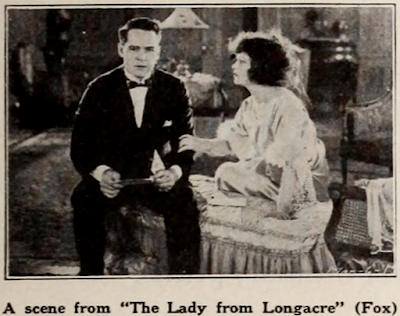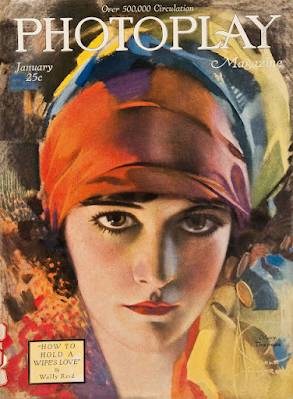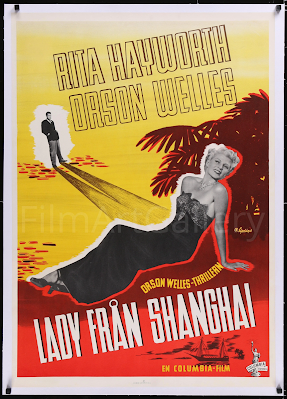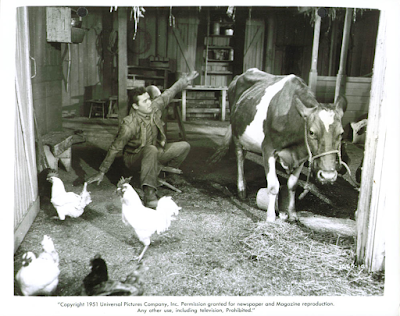Wonderland Burlesque's
Let's All Go To The Movies
She's A Lady!
Part XVIII
Yes, sometimes? It takes a lady.
And it doesn't matter where they come from!
Or so these films would have us believe.
They promise lots of drama, the occasional comedy or musical, and a little bit of dirt!
Let's take a walk down Hollywood Blvd. and shine a light on these magnificent classic films.
This way, if you please. But remember...
Ladies first!
--- ---
The Lady From Longacre
(1921)
To escape a loathsome marriage to the king of a neighboring principality, Princess Isabel flees her kingdom for England, where she is rescued by Lord Anthony Conway. His friends are distressed by his gay escapades, and they rebel when he encourages them to entertain the princess, assuming her to be an actress, Molly Moncke, whom she strongly resembles. Returning to her country with the Englishman, she realizes that she must marry the neighboring king to save her country, in spite of her love for Lord Anthony; but she finds that the king has been seduced by the charms of actress, Molly Moncke, whom he marries, leaving the princess happy with Anthony.
Based on the 1918 novel The Lady from Long Acre by Victor Bridges, this lost American silent drama was directed by George Marshall and stars William Russell, Mary Thurman and Mathilde Brundage.
This film was later remade as the 1925 film Greater Than a Crown.
Mary Thurman was an actress during the silent film era. She made her film debut in 1915 and was a top-billed star by 1919. She also helped popularize the hairstyle known as 'the Dutch bob' favored by the era's flappers. In 1924 while working on the film Down Upon the Suwanee River in Florida, she came down with a serious case of pneumonia. Suffering from the illness, she was hospitalized for nearly a year. Thurman died of pneumonia in New York City on December 22, 1925, in Flower Hospital. Her best friend, actress Juanita Hansen, was at her bedside when she died. She was buried in Richfield City Cemetery in her hometown of Richfield, Utah.
The Lady's From Kentucky
(1939)
Written by Malcolm Stuart Boylan from a story by Rowland Brown, this romantic comedy was directed by Alexander Hall and stars George Raft, Ellen Drew, Hugh Herbert, Zasu Pitts, and Louise Beavers.
The film was originally known as Racing Form and was always to have been a vehicle for George Raft. It went through several female leads. After filming the title was briefly changed to The Gambler and the Lady but it soon reverted to The Lady's from Kentucky.
Frances Dee was the first female star announced to co-star, then Shirley Ross, and then Frances Lee, before Ellen Drew landed the part. At one point, Raoul Walsh was slated to direct.
The reason for all the changes? Raft was suspended by Paramount for refusing to make St Louis Blues. He rejoined the studio on October 5, 1938. By that point, due to scheduling conflicts, Walsh was replaced by Alexander Hall as director and Ellen Drew had been selected as Raft's co-star.
The film was shot partly on location at Oceanside near San Diego. A real foal was born during the making of the film.
The film was the last George Raft would make as part of his his contract with Paramount Pictures. Filming ended in January of 1939 and Raft left the studio for good after refusing to make The Magnificent Fraud.
The New York Times said the film "affirms the old Hollywood faith in good breeding, two-legged and four, by demonstrating once again that the New York gambler turned loose to graze in the Bluegrass inevitably comes a spiritual cropper and awakens a new and better man" conceding that "the picture moves briskly enough"
The Lady From Cheyenne
(1941)
Fictionalized story of the 1869 adoption of women's suffrage in Wyoming Territory. In the newly-founded railroad town of Laraville, Boss Jim Cork hopes to manipulate the sale of town lots to give him control, but Quaker schoolmarm Annie Morgan bags one of the key lots. Cork's lawyer Steve Lewis tries romancing Annie to get the lot back, finding her so overpoweringly liberated that she leaves him dizzy. Still, Steve manages to get his hands on the lot - almost. For soon he learns to deeply regret rousing the sleeping giant of feminism!
This American comedy western was directed by Frank Lloyd and stars Loretta Young, Robert Preston and Edward Arnold.
The film was shot at Universal Studios, and on location in the Mojave Desert.
Made for $535,000, it came in under its scheduled budget of $622,000.
--- ---
The Lady From Shanghai
(1947)
Michael O'Hara, against his better judgement, becomes a crew member on Arthur Bannister's yacht, sailing to San Francisco. They pick up Grisby, Bannister's law partner en route. Bannister has a wife, Elsa, who seems to like Michael much better than she likes her husband. After they dock in Sausalito, Michael goes along with Grisby's weird plan to fake his (Grisby's) murder so he can disappear untailed. He wants the $5000 Grisby has offered, so he can run off with Elsa. But Grisby turns up actually murdered, and Michael gets blamed for it. Somebody set him up, but it is not clear who or how. Bannister, who might be the actual murderer, defends Michael in court!
According to Orson Welles, this film grew out of an act of pure desperation. Welles, whose Mercury Theatre company produced a musical version of Around the World in 80 Days, was in desperate need of money just before the Boston preview. Mere hours before the show was due to open, the costumes had been impounded and unless Welles could come up with $55,000 to pay outstanding debts, the performance would have to be canceled. Stumbling upon a copy of If I Die Before I Wake, the novel upon which this film is based, Welles phoned Harry Cohn, instructing him to buy the rights to the novel - offering to write, direct and star in the film so long as Cohn would send $55,000 to Boston within two hours. The money arrived, and the production went on as planned.
Columbia Pictures boss Harry Cohn told Orson Welles he would never again hire one man to produce, direct and act because he could never fire him.
The cast was frequently frustrated and confused, arriving on the set to find Orson Welles rewriting the script from day to day. His method of working with his actors was often harsh and manipulative. Sometimes he deliberately rattled them to get nervous, edgy performances. Other times he would cause them to forget their lines so they could improvise new ones. One such line that survives on screen was made up on the spot by a flustered Erskine Sanford as the judge: "This isn't a football game!"
Orson Welles originally wanted Barbara Laage for the lead, and for the film to be, in his own phrase, "a B-movie", to be made quickly and cheaply. Harry Cohn of Columbia Pictures nixed the idea of using the unknown Laage and insisted the film become a star vehicle for the studio's biggest name, Rita Hayworth, envisaging a follow-up to the phenomenally popular Gilda. Although Welles's marriage to Hayworth was nearing an end, the director agreed, and the film became the most expensive one he ever made in Hollywood, with a protracted shooting schedule.
Orson Welles' decision to have Rita Hayworth cut her hair and bleach it caused a storm of controversy, and many in Hollywood believed it contributed to the film's poor box-office returns. "Orson was trying something new with me, but Harry Cohn wanted The Image—The Image he was gonna make me 'til I was 90," Hayworth recalled. "The Lady from Shanghai was a very good picture. So what does Harry Cohn say when he sees it? 'He's ruined you - he cut your hair off!'"
Orson Welles thought of Everett Sloane as primarily a radio actor who didn't move particularly well on film, so he introduced crutches to the character. Sloane refused to the wear leg braces made for the character, complaining bitterly of the pain they caused and was reportedly impossible to deal with, shunning everyone on the set.
When Glenn Anders arrived on set his first day, Orson Welles immediately ordered him to lie down on a stretcher under a sheet and play dead. The actor did as instructed and while he lay there, he said a studio rep handed him a pen and a contract to sign. At that point, Anders claimed, he still knew nothing about the film or the part he was playing. Over the course of shooting, Anders became so upset about Welles' bullying, the crew dubbed him 'Glenn Anguish'.
An assistant cameraman, working bareheaded in the blazing sun, suddenly dropped dead of a heart attack. The often-drunk Errol Flynn tried to put him into a duffel bag, and Orson Welles immediately sent someone ashore to alert authorities before Flynn could bury the man at sea.
The Mexico shoot was plagued by a number of problems, many of them detailed by producer William Castle in his diary. During the day the temperature was usually blisteringly hot, and at least once Rita Hayworth collapsed from the heat. At night millions of poisonous insects swarmed around the arc lights, often blotting them out. One insect caused a substantial delay in shooting when it bit Orson Welles and his eye swelled shut, growing almost three times its normal size. Hayworth became ill while shooting in Mexico, and the production had to close down for a month. Cohn and the studio unfairly criticized Welles, blaming him for the film go over budget.
Welles never viewed the rushes. He simply shipped them off to Viola Lawrence, Columbia's chief editor, who had been assigned to the picture. When she saw that Welles had not shot a single close-up, not even one of Rita Hayworth, she went immediately to Columbia boss Harry Cohn, who ordered the director to film some. On location Welles ignored the command, although he finally complied upon returning to the studio.
Near the end of shooting, Welles told Columbia executives that he wanted a complete set repainted on a Saturday for shooting on Monday. Columbia exec Jack Fier told Welles it was impossible, because of union rules and the expense that would be incurred by calling in a crew of painters to work on a weekend. Welles and several friends broke into the paint department that Saturday and repainted the set themselves, and when they were finished they hung a banner on the set that read "The Only Thing We Have to Fear is Fier Himself." When the union painters arrived at work on Monday and saw that the set had been repainted by someone else, they refused to work, threw a picket line around the studio and threatened to stay on strike until a union crew was paid triple time for the work that had been done (which was why Fier had refused to authorize the work in the first place). To placate the union, Fier agreed to pay them what they wanted but put the cost on Welles' personal bill. In addition, he had the union painters paint a banner saying "All's Well That Ends Welles."
Welles was very displeased with the score put together by the studio-appointed composer. In a test screening, he put a temp stock score on which was supposed to serve as a model for the composer. The composer completely disregarded Welles' precisely laid-out blueprint. In particular, the final mirror scene was supposed to be unscored, to create the sense of terror. Of the music accompanying Elsa's dive into the water, Welles said it was more suitable "for some antic moment in a Silly Symphony, a pratfall by Pluto the Pup, or a wild jump into space by Donald Duck."
Welles wanted to pattern the funhouse on the expressionist images of The Cabinet of Dr. Caligari (1920). Stephen Goosson designed an elaborate set with sliding doors, distorting mirrors and a 125-foot zigzag slide from the roof of a studio sound stage down into a pit that was 80 feet long, 40 feet wide and 20 feet deep. The Hall of Mirrors maze was designed with the help of special effects wizard Lawrence W. Butler, who had provided the screen magic in such films as Things to Come (1936) and The Thief of Bagdad (1940). It contained 2,912 square feet of glass. Some of the mirrors were two-way, allowing Charles Lawton Jr. and his crew to shoot through them. Other times they shot through holes drilled in the glass.
The Central Park scene was shot using a carriage that was bought in Mexico and shipped to New York. Huge arc lights, a sound boom and a 20-foot camera crane followed the carriage nearly a mile to get a single dolly shot. Unfortunately, it was later cut by the editor Columbia brought in to fix the picture, completely ruining Welles's concept.
After the film was screened for Columbia Pictures president Harry Cohn, he found it so incomprehensible he offered $1,000 to anyone who could explain the plot to him. Later he decided to clarify the film by beginning it with the trial scene and telling the preceding part of the story in flashbacks, but abandoned the plan because so much new footage would have had to be shot it would have nearly doubled the film's cost.
Columbia Pictures chief Harry Cohn thought the movie would ruin his star, Rita Hayworth, and held the release back for one year. He ordered director Orson Welles to insert glamour shots (close-ups) of Hayworth. Because of the success of Hayworth's singing in other films, Cohn also ordered filming of the scene where Hayworth sings Please Don't Kiss Me.
The film was a financial disaster when it was released.
Rita Hayworth
--- ---
The Lady From Texas
(1951)
This marked the final film appearance for Josephine Hull, who had delighted audiences in Arsenic and Old Lace (1944) and won an Academy Award and a Golden Globe for Best Supporting Actress for her work in Harvey (1950). She returned to the stage, where her career had begun and took on the occasional role on television.

































































































































1 comment:
Wow...now there's an actor I hadn't heard about in decades: Zazu Pitts.
Post a Comment